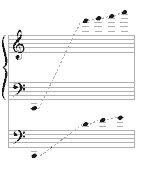| WAC Main Page | |||||
| Newsletter Front Page | |||||
| On the Nature of the Beast That Does Not Breathe | |||||
| Introduction | |||||
| A Few Words about Organ Actions | |||||
| Some Basics of Notation | |||||
| Registrations | |||||
| Extended Techniques | |||||
| A Few Final Truths | |||||
| Appendixes | |||||
Some Basics of Notation
Typically, organ music is notated on three staves, with the top stave for the right hand, the middle for the left hand, and the bottom for the feet; the top two staves are bracketed together, and typically the barlines are drawn through the top two staves, with separated bar lines for the pedal, although all three staves may share one bar line or have separated bar lines.



For extended passages where the feet are not used, one may drop the bottom stave. In some situations, particularly where very fast manual changes are required or the technique known as "thumbing" is required, four or five staves may be used as necessary. There is no reason to use more than five staves at any point and no reason for using more than three staves for more than a few systems at a time. The opening registration is typically written in the upper left corner of the first page, and each registration change is notated above or below the staff it affects at the point the change is made. A composer should also keep in mind when notating the score that the most typical console designs require the organist to maintain either a very wide field of vision or a very tall one, and that on a large organ the score is a fair distance from the organist.
Another notational issue regards the range(s) of the organ. One notational option that has been used by some composers is to write the precise pitches they desire and leave it up to the organist to figure out how to realize the piece as presented. While there is nothing inherently wrong in doing this--and in some situations, it may be the best solution given the nature of the piece--composers who choose to notate their piece in this manner should add a note on the first page of their score stating that this is the case! The more typical method is to notate the piece within the generally accepted ranges of the manuals and pedals and use the registrations to place the pitches in the proper octaves. The currently accepted bottom note on both the manuals and the pedals is two octaves below middle c:

The typically accepted top note for the manuals is between four and five octave above this c; the top note of the pedals is typically between two octaves and two octaves and a fifth above this c:

On The Nature of the Beast That Does Not Breathe
[Introduction] [A Few Words about Organ Actions] [Some Basics of Notation]
[Registrations] [Extended Techniques] [A Few Final Truths] [Appendixes]
[WAC Main Page] [Newsletter Front Page]
Copyright © 2000 David Bohn. All rights reserved.
Last updated 12 November 2000. Contact information.